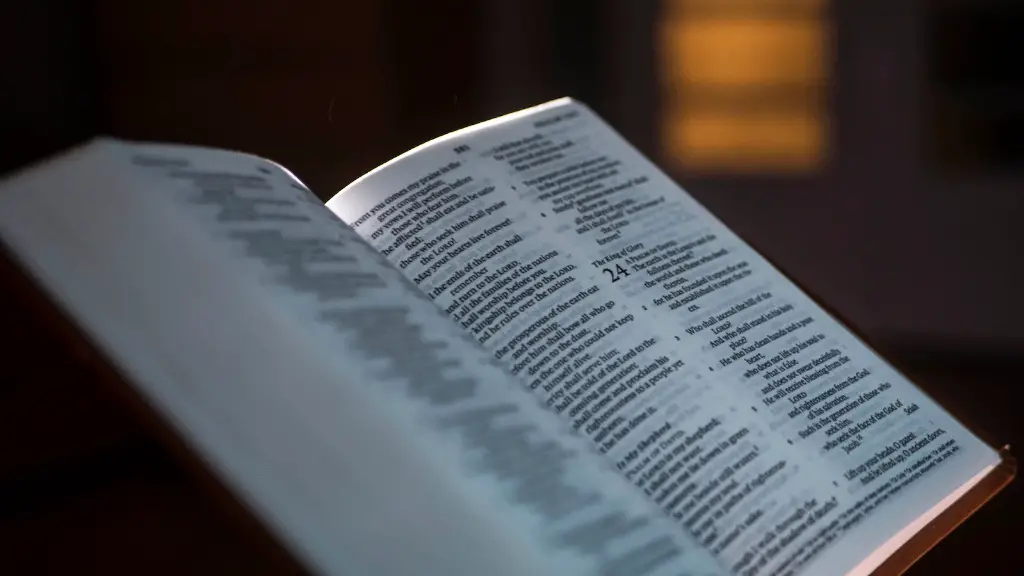The Bible is full of references to flowers, from the lilies of the field to the rose of Sharon. Flowers are used as symbols of God’s love and care for his people, as well as symbols of the hope and new life that comes from Christ.
The Bible contains many references to flowers, plants, and trees. For example, Solomon’s temple was adorned with beautiful floral carvings (1 Kings 6:18, 29). Flower imagery is used throughout the Bible as a symbol for that which is temporal and will eventually fade away—in contrast to that which is everlasting. “The grass withers, the flower fades” (Isaiah 40:7). This is seen most clearly in the New Testament, where Jesus speaks often of Himself as the “true vine” (John 15:1) and His followers as the “branches” (John 15:5). As the vine signifies eternal life, so the flowers of the field point to the transitory nature of human life. “Look at the flowers of the field; they do not labor or spin. Yet I tell you that not even Solomon in all his splendor was dressed like one of these” (Matthew 6:28-29).
What do flowers Symbolise in the Bible?
The flower is a symbol of the natural world and its beauty, which is why it is often used in religious art and iconography. The flower also symbolizes the fragility of life and the transience of beauty. In the Bible, the flower is often used as a metaphor for the fall of humankind. Just as the beauty of a flower fades and eventually dies, so too does the beauty of humanity.
The Carnation is a beautiful flower that has a rich history. It is said that the Carnation is the flower of god, as it is a fusion of the Greek words “dios” and “anthos”. Zeus, the Greek god, is depicted by “dios”, and “anthos” means flower. That’s why the Carnation is recognized as “God’s Flower”. The Carnation is a symbol of love, purity, and innocence, and is a perfect way to show your appreciation and admiration for someone special in your life.
What Scripture talks about beauty of flowers
Isaiah 28:1 is a warning to the people of Ephraim who are prideful and drunkards. Their city will be laid low and their beauty will fade. This is a warning to all those who are prideful and think they are above others. We must all humble ourselves and be careful not to become arrogant.
Pinks are beautiful flowers that hold deep Christian significance. They were associated with the nails used in the Crucifixion and coronations, while the name dianthus translates to “flower of God” (from the original Greek Dios for Zeus), and can be found represented in numerous illuminated manuscripts. Pinks are a reminder of the sacrifice that Jesus made for us and the deep love that God has for us. They are also a symbol of hope and new beginnings.
Why are flowers offered to God?
The significance of flowers is that they are a beautiful and fragrant way to show our love and appreciation for God, the creator of every living being. Indian mythology says that when God comes down to Earth, he always stays at a beautiful and fragrant place. Flowers are the best suited and most sounding things amongst Mother Nature to show our love for God.
Peristeria is a highly famous orchid. Flowers of this stunning orchid resemble a dove, hence comes its common name, the Dove Orchid. This orchid is also frequently referred to as the Holy Spirit Orchid, or the Holy Ghost Orchid.
What flower represents God’s love?
Roses have been a popular flower for centuries and their meaning has vary depending on the culture. In Christianity, roses stand for love or as a sign of Christ’s blood. For Catholics, the rose serves as a symbol of the rosary, which Catholics use during prayer and also to commemorate several important events in Christ’s life.
If you’re planning on offering flowers to any of the Hindu Gods, it’s important to know which ones to avoid. Many flowers have negative connotations in Hinduism, and some are even said to anger the Gods. Here are four flowers that you should never offer to the Gods:
1. Ketaki or Kewada: These flowers are associated with death and are said to anger Lord Shiva.
2. Amla or Arka: These flowers should never be offered to Goddess Parvati.
3. Bael leaves: These should never be offered to the Sun God.
4. Arali or Nerium Oleander: These should never be offered to Lord Ram.
What is the Heaven flower
Pansies are beautiful flowers that have a special meaning. They are often seen on tombstones, which symbolizes the connection between the flower and the afterlife.
Flowers play an important role in the Bible, both symbolically and literally. From the anemone to the hyssop, each flower has its own unique meaning and purpose.
The anemone, for example, is a symbol of Christ’s resurrection. The black cumin is mentioned in the book of Isaiah as a plant that will bring healing to the nations. The broom is mentioned in 1 Kings as a plant that Elijah used to cleanse the altar of God.
The daffodil is a symbol of purity and hope, while the henna is a symbol of joy and celebration. The hyssop is a symbol of cleansing and purification.
Each of these flowers has its own special meaning and purpose in the Bible. May we take time to notice the beauty of these flowers and reflect on the deeper meaning that they symbolize.
What is the power of flowers?
The Power of Flowers Project is a wonderful way to spread hope and happiness to those who may need it the most. By delivering bouquets of flowers to seniors and veterans in care communities, our volunteers are able to brighten someone’s day and improve their overall wellbeing. It’s a small act of kindness that can make a big difference in someone’s life.
These flowers all have religious significance and are often used in religious ceremonies and celebrations. Christmas Rose is associated with the birth of Jesus, Candlemas Bells is associated with the Presentation of Jesus at the Temple, Annunciation Lily is associated with the announcement of Jesus’ birth to the Virgin Mary, Lent Lily is associated with the period of Lent, Easter Lily is associated with the resurrection of Jesus, Ascension Flower is associated with the Ascension of Jesus, Pentecost Flower is associated with the descent of the Holy Spirit at Pentecost, Corpus Christi Flower is associated with the Eucharist, Assumption Flower is associated with the Assumption of Mary, All Saints Flower is associated with All Saints’ Day, and there are also numerous flowers of the saints which have their own individual meanings.
What flower means blessing
The cornflower is a special bloom that holds a great deal of meaning and blessing. Its delicate blue color is a symbol of strength and resilience, and its ability to thrive in a wide range of environments is a reminder that we, too, can thrive no matter what challenges we face. When we see a cornflower, we are reminded to have faith in ourselves and our ability to overcome any obstacle.
Setiechinopsis Mirabilis is a small cactus that is easy to grow. It has a tall, green stem that is covered with short, dark spines. The plant is known for its beautiful flowers, which are white with purple stripes.
What is the flower of forgiveness?
The Narcissus, also known as the Daffodil, Jonquil, or Paperwhite, is the flower of December. This cheerful flower is a symbol of forgiveness and appreciation.
The honeysuckle is a beautiful plant that is admired for its sweet scent and trailing vines of pink and orange flowers. This plant is known to symbolize devoted and everlasting love. If you are looking for a way to show your loved one how much you care for them, consider giving them a gift of a honeysuckle plant.
Is there a flower called faith
The Faith rose is a beautiful lavender rose with pink and cream hues. It has a large head that opens nicely with plenty of petals. It doesn’t have a strong fragrance, but it is still a lovely rose.
White flowers such as white roses and lilies are used in Christianity to stand for purity, and they are sometimes used in conjunction with references to the Virgin Mary to represent her own purity. Red roses in Christianity stand for love or as a sign of Christ’s blood.
Final Words
The Bible does not explicitly mention flowers, but it does paint a picture of a world full of color and life. For example, in the Song of Solomon, the lover extols the beauty of his beloved, comparing her to a field of flowers (4:1-3). Elsewhere, the Bible describes the world as being full of “flowers of all kinds” (Isaiah 28:1). This imagery no doubt reflects the author’s experience of living in a world full of natural beauty.
While the Bible does not include a direct teaching about flowers, it is clear that God delights in color and life. This is seen in the many references to flowers throughout Scripture. In the New Testament, for instance, Jesus compares the kingdom of heaven to a “mustard seed” that grows into a large tree, with branches that provide shelter for birds (Matthew 13:31-32). The image of a tree bearing flowers and fruit is also used in Revelation 22:2 to describe the holy city, which is coming down from heaven.
It is safe to conclude that, since God created the world and all that is in it, including flowers, He must delight in them. Their beauty brings Him glory and brings
The Bible is full of references to flowers, from the lilies of the field to the rose of Sharon. Flowers are seen as a symbol of hope, beauty, and new life. In the Bible, flowers are often associated with love, joy, and peace.





